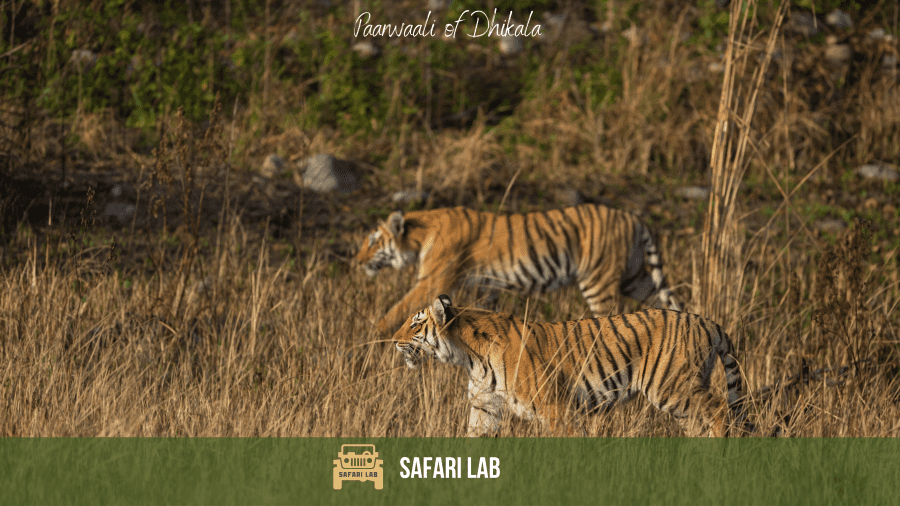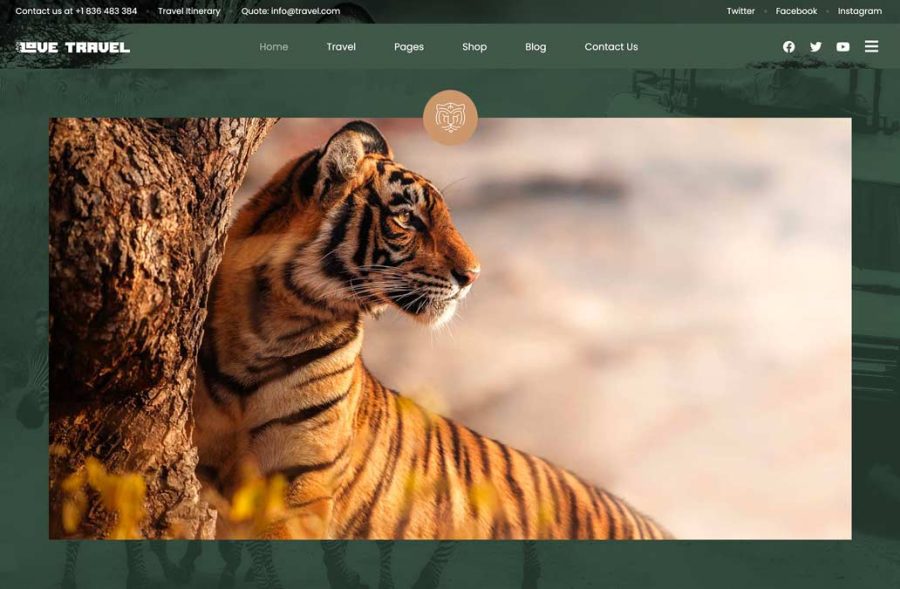India is famously known for its impressive wildlife, including its majestic big cats – the Bengal tigers. These famous tigers of india are among the most prominent wild cats worldwide, attracting an immense fascination among wildlife lovers and nature enthusiasts alike.
Did you know that India has more than 70% of the world’s Bengal tigers population? These big cats have a significant role in Indian wildlife, making them an essential icon of the country’s rich biodiversity.
In this blog post, we’ll take you on a journey through India’s national parks and tiger reserves, where you can find some of the most famous tigers in India. From Ranthambore National Park to the Sundarbans National Park, we’ll explore the significance of these tiger reserves and the wildlife conservation efforts in place to protect these endangered species.
Jump To
ToggleKey Takeaways:
- India is the home to more than 70% of the world’s Bengal tigers population, making it a must-visit destination for wildlife enthusiasts worldwide.
- National parks and tiger reserves such as Ranthambore, Jim Corbett, Bandhavgarh, Kanha, and Sundarbans are some popular destinations to spot these big cats.
- Bengal tigers are endangered species in India, and wildlife conservation efforts have been implemented to protect these majestic creatures.
- Wildlife photography enthusiasts can learn tips and techniques to capture breathtaking images of these famous tigers in India.
- Tourism can have both positive and negative impacts on tiger conservation, and sustainable tourism practices are needed to maintain a balance between the two.
The Majestic Bengal Tiger
When it comes to the famous tigers in India, the Bengal tiger captivates the hearts and minds of wildlife enthusiasts around the world. Known for its powerful build, distinctive orange coat with black stripes, and incredible strength and speed, the Royal Bengal tiger is a true symbol of the Indian wildlife.
These majestic big cats are not only beautiful but also elusive, making every sighting a special moment. With a natural habitat that ranges from tropical forests and swamps to grasslands and savannas, the Bengal tiger is a versatile predator, adaptable to various environments and conditions.
One unique characteristic of the Bengal tiger is its affinity for water. Unlike most big cats, Bengal tigers are comfortable in and around water, making them excellent swimmers. They even have partially webbed paws to aid them in their aquatic pursuits.
If you are fortunate enough to encounter one of these gorgeous animals in the wild, it’s important to be safe and cautious. Always respect their space and never approach them too closely.
Capturing stunning photographs of these famous tigers requires patience, skill, and the right equipment. Check out our next section for tips on capturing the perfect shot of Bengal tigers in their natural habitat.
Maya – The Enchantress of Tadoba
Maya, whose name signifies the supernatural power by which the world is manifest, lived up to her name as one of the most charismatic and photographed tigers in the world[^1]. Her moniker, ‘Tiger Queen of Taru,’ was partly due to a distinctive mark resembling the alphabet ‘M’ on her shoulder, which contributed to her enchanting reputation[^2].

Maya’s fame extended beyond her striking appearance; she was a major crowd-puller and played a significant role in generating the economy for Tadoba National Park. Her presence made Tadoba so popular that her name became synonymous with the reserve itself. Unfortunately, Maya, also known as T-12 or the ‘Queen of Tadoba,’ passed away due to natural causes, leaving behind a legacy that had significantly impacted the region.
Legacy The legacy of Maya continues to resonate through Tadoba Andhari Tiger Reserve, where she was a resident. She was not only a symbol of the park’s wildlife but also a testament to the intricate relationship between such majestic creatures and the ecosystems they inhabit.
Famous Tigers of India – Collarwali
The story behind the name “Collarwali” is rooted in a significant event that took place in 2008 when she became the first tigress in Pench Tiger Reserve to be fitted with a radio collar. This technological advancement not only gave her the Hindi nickname “Collarwali,” meaning “collar-wearer,” but also marked the beginning of a new era in tiger conservation and study within the reserve.
An interesting anecdote about Collarwali’s life is that despite a rocky start as a mother when her first litter succumbed to pneumonia, she went on to earn the title of “supermom.” Over her lifetime, she gave birth to 29 cubs across eight litters, contributing significantly to the tiger population in Pench Tiger Reserve. Her remarkable maternal success made her a legend among tigers and an icon of wildlife conservation efforts.
Collarwali’s legacy is multifaceted; she was not only a symbol of successful conservation efforts but also a beacon of hope for the future of tigers in India. Her prolific motherhood helped sustain the tiger population in the region, and her monitored life provided valuable data for wildlife researchers. Even after her death at the age of 17 due to multiple organ failure, Collarwali remains a celebrated figure in the history of Pench Tiger Reserve and a testament to the resilience of nature.
Famous Tigers of India – Ustad (T-24)
Ustad, also known as T-24, was a tiger whose name reflected his commanding presence; “Ustad” means “master” or “expert” in Hindi. He was renowned for his fearless nature and was often seen dragging his prey onto the highway, unfazed by the presence of humans.
However, Ustad’s interactions with humans led to controversy when he was labeled a “man-eater” after being linked to the deaths of at least four individuals. This resulted in his removal from the wild in 2015 and relocation to captivity, where he spent the remainder of his life.
Ustad’s legacy is a complex one, as it highlights the delicate balance between tiger conservation and human-tiger conflict. His death in captivity on December 28, 2022, after suffering from health issues including cancer, marked the end of a storied life that continues to provoke discussions about the management of tigers that come into conflict with people.
Wagdoh
Wagdoh, known as “Asia’s biggest tiger,” was a legendary figure in Tadoba National Park. His name “Wagdoh” was derived from the local language, and he was also referred to as “ScarFace” and “Big Daddy of Tadoba” due to his formidable size and dominant presence.
One of the most fascinating anecdotes about Wagdoh is his impressive contribution to the gene pool of tigers in Tadoba. He fathered 40 cubs, leaving behind a significant legacy that bolstered the tiger population in the reserve].
Wagdoh’s legacy is not just in numbers but also in the impact he had on wildlife tourism and conservation awareness. His popularity among wildlife enthusiasts made him a subject of extensive photography and admiration, helping to draw attention to the importance of tiger conservation efforts in India.
Munna – The CAT
Munna, a tiger of considerable fame in India’s Kanha National Park, was known for the distinctive markings on his forehead that resembled the letters “CAT”. This unique feature made him a beloved figure among visitors and wildlife enthusiasts alike. The story behind Munna’s name is as intriguing as his appearance; he was named after a guide with a limp, which Munna himself developed after injuring his foot in a territorial clash.
Munna’s legacy extends beyond his striking markings. He was a dominant force in the Kisli zone of the park, where he was often seen by tourists and became an iconic representation of the wild beauty of Kanha. His presence in the park was so impactful that even after his limbs were paralyzed, preventing him from moving, his story continued to captivate those who heard it.
Interesting anecdotes about Munna include his long reign over the Kisli zone and the endearing way he acquired his name. His fame was such that people would come from far and wide just to catch a glimpse of the OG CAT of Madhya Pradesh’s Kanha. Munna lived to be around 21 years old, a testament to his resilience and the conservation efforts within the park.
In summary, Munna’s story is one of majesty and endurance, leaving a lasting impression on the narrative of India’s wildlife. His name, derived from a human counterpart, and his famous “CAT” markings are emblematic of the deep connections between humans and nature, and the stories we share with the wild inhabitants of our planet.
Jai
Jai, the famous Indian tiger, was named after a character from the classic Bollywood film “Sholay.” The character, portrayed by Amitabh Bachchan, was known for his bravery and strength, traits that resonated with the majestic tiger. Jai’s name became synonymous with his own legendary status as he captured the nation’s attention through his remarkable journey in search of a mate. This journey saw him traverse through villages, rivers, and dangerous highways, showcasing his resilience and determination.
An interesting anecdote about Jai involves his epic migration, which led to widespread fame. In 2013, Jai traveled nearly 150 kilometers from the Nagzira-Navegaon Tiger Reserve to the Umred-Karhandla Sanctuary, crossing human-dominated landscapes and highlighting the adaptability and courage of this incredible animal. His ability to navigate such challenging environments not only demonstrated his impressive survival skills but also brought to light the issues of habitat fragmentation and the need for wildlife corridors.
The legacy of Jai is a poignant one. Despite his celebrity status among conservationists and wildlife enthusiasts, his disappearance sparked concern and highlighted the dangers that tigers face in the wild. Reports suggest that Jai may have met a tragic end due to electrocution on a farm, an incident that underscores the human-wildlife conflict and the perils that come with it. Jai’s story serves as a reminder of the importance of tiger conservation and the need to protect these magnificent creatures and their habitats for future generations.
Paarwali – One of the most Famous Tigers of India
The Dhikala zone of Jim Corbett National Park is home to a renowned tigress known as Paarwali, a name that resonates with wildlife enthusiasts and photographers alike. The moniker ‘Paarwali’ was bestowed upon her due to her preference for the territories across the river, or “paar” in the local language, which she frequented and where she was often sighted. This majestic Bengal tiger has captivated the hearts of many who visit the park, becoming a star attraction and a favorite subject for those looking to capture the essence of India’s wild tigers in their natural habitat.

Paarwali’s legacy extends beyond her name and the awe she inspires among visitors. She has been observed by the side of a shallow pool with her cubs, showcasing the intimate and hidden life of a tiger family. Such moments offer a rare glimpse into the tender side of these otherwise solitary and elusive creatures, further cementing Paarwali’s status as an icon of the park.
The Dhikala Zone, where Paarwali resides, is the most popular area within Jim Corbett National Park for tiger sightings, thanks to its open grasslands, river channels, and dense Sal forests. It is this very landscape that provides the backdrop for Paarwali’s story—a tale of survival, motherhood, and the intricate dance of predator and prey within one of India’s most celebrated national parks.
In summary, Paarwali of the Dhikala zone is not just another tiger; she is a symbol of the wild beauty that Jim Corbett National Park preserves and a living testament to the rich biodiversity that thrives within its boundaries. Her story is one of many that continue to inspire conservation efforts and draw visitors from around the world, eager to witness the majesty of the tiger in its natural realm.
Nantu – The Myth of the Sundarbans
The story behind the name of the Sundarbans tiger known as Nantu is not explicitly detailed in the provided sources. However, tigers in the Sundarbans have a unique and fearsome reputation due to their history of human-tiger conflict. The name “Nantu” itself may be locally derived, but the specifics of its origin are not clear from the available information.
Interesting anecdotes about the Sundarbans tigers, including Nantu, highlight their notoriety in local folklore and the danger they pose to humans. Historically, these tigers were known to kill fifty or sixty people a year, a fact that contributed to their fearsome legacy. They are also known for being powerful enough to destroy small wooden boats, which adds to the aura of danger surrounding them. These tigers are slightly smaller and slimmer than those found elsewhere in India, yet they remain extremely powerful predators within their mangrove forest habitat.
The legacy of the Sundarbans tigers, such as Nantu, is deeply intertwined with the cultural fabric of the region. They are not only apex predators that play a crucial role in maintaining the balance of their ecosystem but also hold significant cultural importance. The Sundarbans tigers are part of the local mythology, where they are associated with the gods and are considered both a muse and a ghostly presence within the mangrove forests. Their existence continues to influence the cultural narratives and conservation efforts in the region, emphasizing the need to preserve this majestic species and its habitat.
Impact of Tourism on Tiger Conservation
India is known for its famous tigers and attracts many visitors to its tiger reserves and national parks. While tourism can bring economic benefits to the region, it also has a significant impact on wildlife conservation.
The tourism industry can have negative effects on the natural habitat of Bengal tigers, leading to the loss of their critical resources. Human activity, such as construction of tourist facilities, can destroy tiger habitats, disrupt their natural behavior, and even displace them from their homes.
On the positive side, tourism can educate people about the importance of wildlife conservation and generate funds that can be used for the protection and preservation of Bengal tigers. Responsible and sustainable tourism practices can contribute to the well-being of local communities and also encourage them to protect tigers and their habitats.
Having a balance between promoting tourism and protecting tigers is essential. A comprehensive management strategy that takes into account the impacts of tourism on the environment and the well-being of local communities should be adopted. In this way, we can ensure the long-term survival of these incredible big cats and their habitats.
Responsible Tourism Practices to Protect Tigers
Here are some guidelines that visitors can follow to promote responsible tourism:
- Do not disturb the natural behavior of tigers.
- Do not litter, and follow the park rules and regulations.
- Do not disrupt the habitat of other wildlife while searching for tigers.
- Support local communities by buying local products and hiring local guides.
- Avoid using plastic and carry refillable water bottles.
By following these practices, tourists can contribute to the protection and conservation of Bengal tigers and their habitats. It is crucial to promote sustainable tourism practices to ensure the survival of not only Bengal tigers but also of many other wildlife species in India.
Conclusion
In conclusion, the famous Bengal tigers of India are not only a significant part of Indian wildlife but also an emblematic representation of the country’s rich biodiversity.
National parks and tiger reserves in India play a vital role in preserving the majestic creatures and their habitat. It is essential to understand the importance of wildlife conservation to ensure the survival of these incredible big cats.
In the mosaic of India’s wilderness, tigers like Maya, Wagdoh, Munna, and Paarwali are not mere animals but narratives of might and mystique woven into the very fabric of the forests they rule.
Each one, a paragon in their right, contributes uniquely to the story of India’s rich natural heritage.
Maya, the enchantress of Tadoba, casts a spell with her grace, while Wagdoh, the dominant force of Tadoba, represents unbridled power. Munna, with his iconic ‘CAT’ markings, delights Central India’s Kanha visitors, and Paarwali embodies the spirit of motherhood within Jim Corbett National Park.
Together, their tales of survival, legacy, and coexistence celebrate the triumphs of conservation and the enduring wild spirit that India proudly strives to protect for the future.
These tigers are not just the heart of India’s jungles but the soul of its ecological grandeur, exuding a presence that continues to captivate, fascinate, and inspire reverence across the globe.
FAQ
What are the famous tigers in India?
The famous tigers in India are primarily the Bengal tigers, also known as Royal Bengal tigers.
Which national parks in India are known for their tiger population?
Some of the national parks in India known for their tiger population include Ranthambore National Park, Jim Corbett National Park, Bandhavgarh National Park, Kanha National Park, and Sundarbans National Park.
Why is wildlife conservation important for tigers in India?
Wildlife conservation is crucial for tigers in India to preserve their habitat, maintain biodiversity, and prevent the decline of endangered species like the Bengal tiger.
Can you provide information about Ranthambore National Park?
Ranthambore National Park is one of the top tiger reserves in India, known for its thriving tiger population. It is located in Rajasthan and offers visitors a unique opportunity to witness these majestic creatures in their natural habitat.
What is the significance of Jim Corbett National Park?
Jim Corbett National Park is renowned for being the oldest national park in India and a prominent tiger reserve. It serves as a vital conservation area for Bengal tigers and offers breathtaking landscapes for wildlife enthusiasts.
Why is Bandhavgarh National Park popular among wildlife enthusiasts?
Bandhavgarh National Park is famous for its high density of tigers, making it an ideal destination for spotting and photographing these magnificent creatures. The park is known for its scenic beauty and robust conservation efforts.
What makes Kanha National Park unique?
Kanha National Park is renowned for its diverse ecosystem and significant tiger population. It is a prime example of successful wildlife conservation and offers stunning landscapes for visitors to explore.
Tell me more about Sundarbans National Park.
Sundarbans National Park, located in West Bengal, is a UNESCO World Heritage Site and a critical habitat for the endangered Bengal tigers. The park’s unique mangrove forests and abundant wildlife make it a remarkable conservation area.
What are the conservation efforts in place to protect Bengal tigers in India?
Several initiatives and conservation efforts are in place to protect Bengal tigers in India. These include government-led programs, involvement of NGOs, and the commitment of local communities towards preserving these majestic creatures.
Are there any photography tips for capturing famous tigers in India?
Yes, there are various photography tips and techniques that can help capture stunning photographs of famous tigers in India. These include understanding their behavior, choosing the right equipment, and maintaining a safe distance to ensure the well-being of both the tigers and the photographer.
How does tourism impact tiger conservation in India?
Tourism has both positive and negative impacts on tiger conservation in India. While responsible and sustainable tourism can contribute to conservation efforts through increased awareness and funding, unchecked tourism can disturb tiger habitats and disrupt their natural behavior.
Recent Posts
Archives
Categories
Customized Trip Form
Author

Sanjay Nair is a multi-award-winning wildlife photographer, conservation storyteller, and co-founder of Safari Lab. With over 15 years of fieldwork and a Nature in Focus award under his belt, Sanjay’s photographs and stories have been published in global outlets such as The Times & The Guardian.
View all posts




























